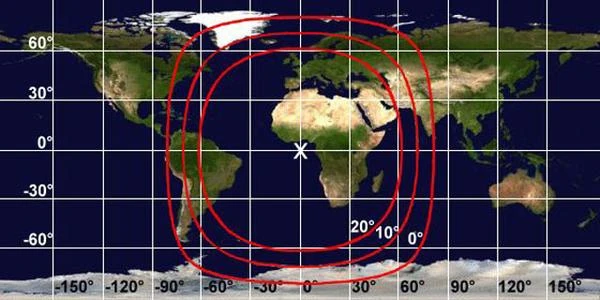
Image description: Geostationary satellites are telecommunications, broadcasting, observation, and meteorological satellites. They are located at an altitude of 35,796 km and have a fixed position relative to the Earth's surface. Their altitude allows them to "see" more than a third of the Earth; three satellites are enough to ensure almost total coverage of the Earth's surface.
The geostationary orbit is a circular orbit at a specific altitude above the Earth's equator, where a satellite remains fixed relative to a point on the Earth's surface. This orbit allows for a constant position in the sky, which is particularly useful for communication and meteorological satellites.
N.B.:
The geostationary orbit is a circular orbit that allows a satellite to complete one orbit around its planet while the planet completes one rotation around itself. Since its inclination relative to the Earth's equatorial plane is 0, the satellite appears "stationary," suspended in the sky always in the same position above the equator. Geostationary satellites are used for continuous observation of a specific area of the Earth.
To understand and calculate a geostationary orbit, it is essential to master certain concepts of orbital mechanics:
The orbital period (T) for a geostationary orbit must match the Earth's rotation period, which is 24 hours or 86,400 seconds. Using Kepler's third law, the formula for the orbit radius (⃒a⃓) is:
\[ T = 2\pi \sqrt{\frac{a^3}{\mu}} \]
By isolating a, we get:
\[ a = \left( \frac{\mu T^2}{4\pi^2} \right)^{1/3} \]
For Earth, with T = 86,400 s, the calculation gives an orbit radius of 42,164 km. The satellite's altitude is obtained by subtracting the Earth's radius (6,378 km):
\[ h \approx 42,164 - 6,378 = 35,786 \, \text{km} \]
Geostationary orbits are used in many fields:
All geostationary satellites are synchronous, but not all synchronous satellites are geostationary.
A geostationary orbit is a special case of synchronous orbit that meets very specific criteria:
This configuration is only possible for satellites around Earth, at an altitude of ~35,786 km, which corresponds to a semi-major axis of approximately 42,164 km.
| Characteristic | Synchronous Orbit | Geostationary Orbit |
|---|---|---|
| Satellite Position | Variable depending on inclination/eccentricity | Always above the equator |
| Apparent Movement | Possible oscillations in the sky | Satellite fixed in the sky |
| Inclination | Can be non-equatorial | 0° (above the equator) |
| Eccentricity | Can be elliptical | 0 (circular orbit) |
| Example of Use | Navigation satellites (other planets) | Telecommunications, meteorology |